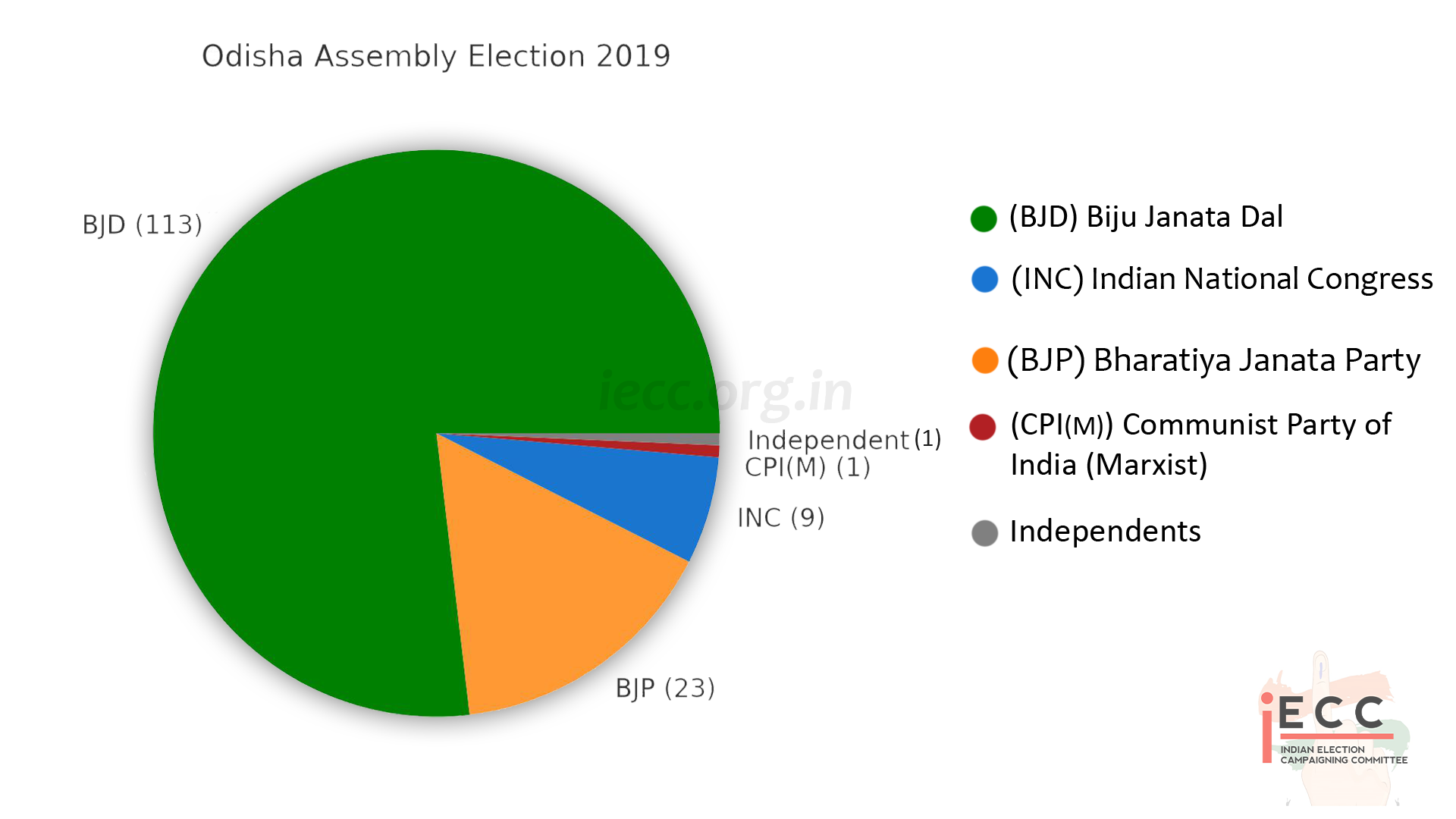Odisha Assembly Election
1952 Odisha Legislative Assembly Election Results
| 1952 Odisha Assembly Election Results | |||
|---|---|---|---|
| Sr. No. | Short Name | Full Name | Seats |
| 1 | INC | Indian National Congress | 67 |
| 2 | GP | Ganatantra Parishad | 31 |
| 3 | Socialist Party | Socialist Party | 10 |
| 4 | CPI | Communist Party of India | 7 |
| 5 | Independents & Others | Independents & Others | 25 |
| Total | 140 | ||
This was Odisha’s first election under universal adult franchise.
The Ganatantra Parishad was formed by former princes and zamindars, and it quickly became a significant regional force in Odisha politics.
Congress remained dominant but could not secure a full majority, showing early cracks in its monopoly.
Despite the opposition, Congress formed the government and continued to rule, benefiting from being the national ruling party.
This election marked the beginning of Odisha’s unique regional politics, with the rise of regional parties like GP (later merged into Swatantra Party).
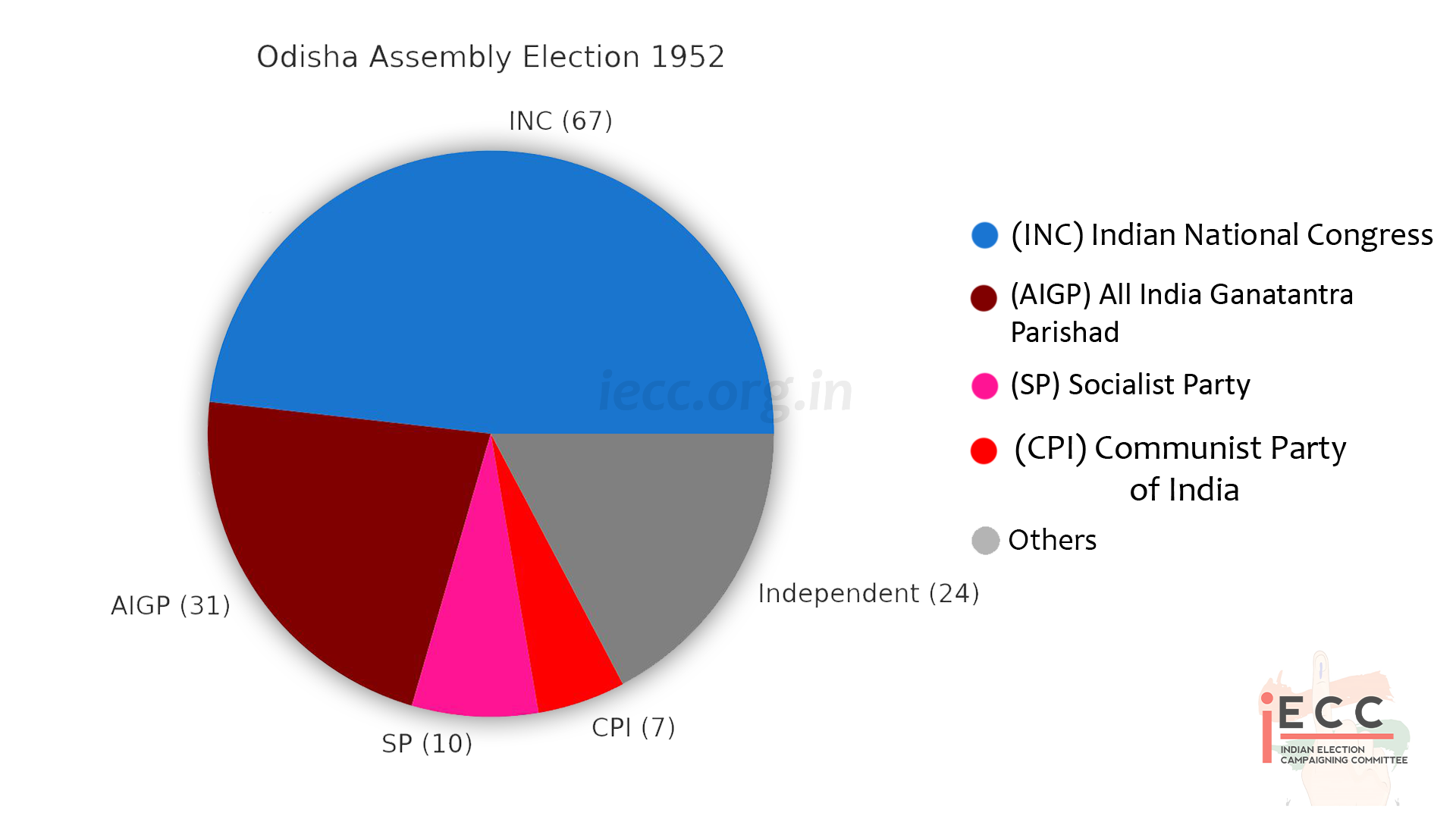
1971 Odisha Legislative Assembly Election Results
| 1971 Odisha Assembly Election Results | |||
|---|---|---|---|
| Sr. No. | Short Name | Full Name | Seats |
| 1 | INC | Indian National Congress | 51 |
| 2 | UC | Utkal Congress | 33 |
| 3 | Swatantra Party | Swatantra Party | 36 |
| 4 | Jharkhand Party | Jharkhand Party | 3 |
| 5 | CPI | Communist Party of India | 8 |
| 6 | Others / Independents | Others / Independents | 9 |
| Total | 140 | ||
The 1971 elections in Odisha were fragmented, with no single party gaining a majority.
The Indian National Congress (INC) became the largest party but fell short of the majority.
Biju Patnaik’s Utkal Congress—a breakaway faction from the Congress—made its debut and became a major force, winning 33 seats.
The Swatantra Party also remained influential with 36 seats, though weaker than in 1967.
Due to the fractured verdict, coalition politics continued in Odisha.
After political maneuvering, Biswanath Das (Utkal Congress) briefly became Chief Minister in 1971 with support from the Swatantra Party and others.
However, instability persisted, and Odisha saw frequent changes in government in the early 1970s.
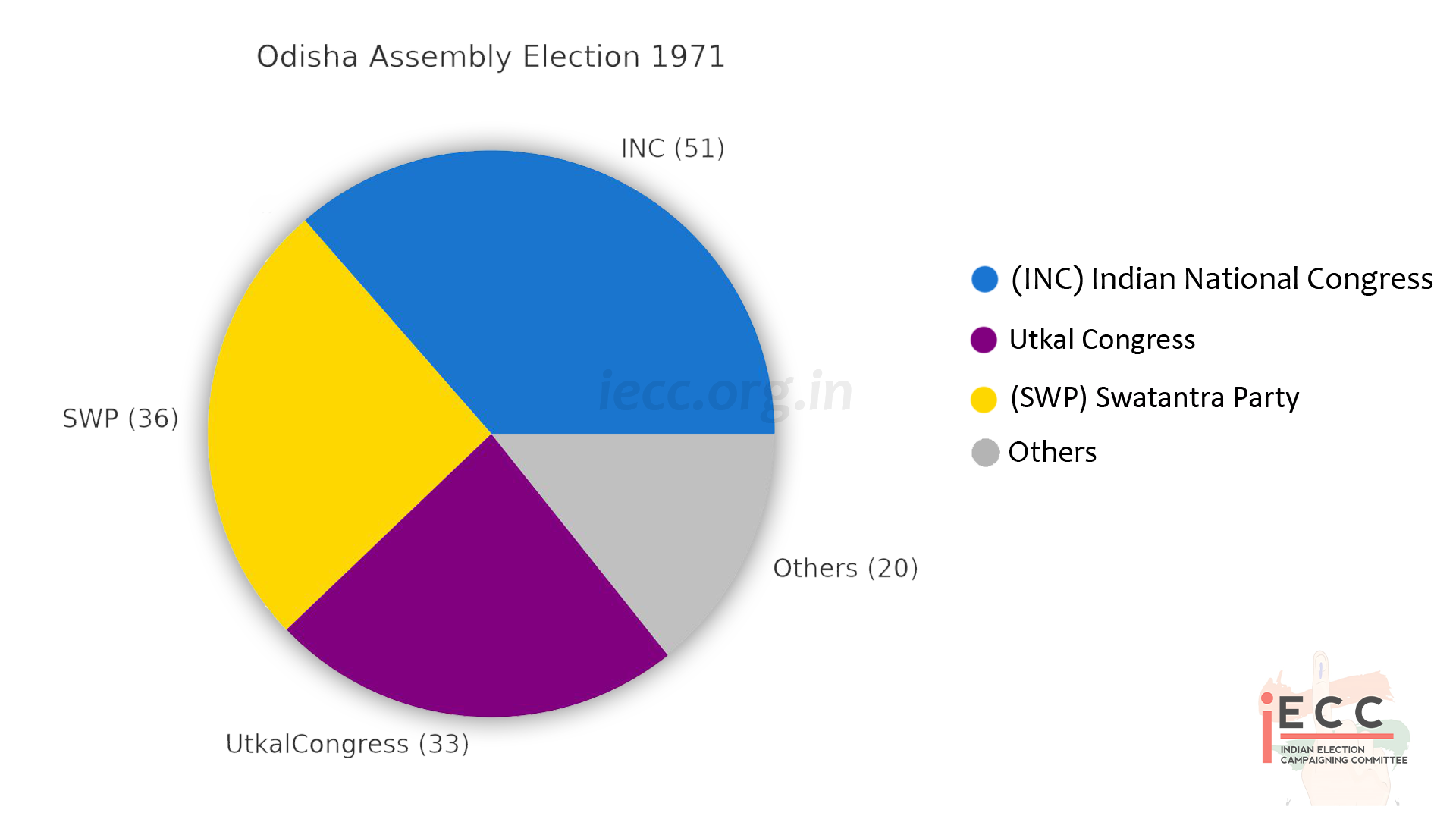
1957 Odisha Legislative Assembly Election Results
| 1957 Odisha Legislative Assembly Election Results | |||
|---|---|---|---|
| Sr. No. | Short Name | Full Name | Seats |
| 1 | INC | Indian National Congress | 56 |
| 2 | GP | Ganatantra Parishad | 51 |
| 3 | CPI | Communist Party of India | 9 |
| 4 | PSP | Praja Socialist Party | 7 |
| 5 | Independents & Others | Independents & Others | 17 |
| Total | 140 | ||
This election clearly showed the rise of regional power in Odisha. The Ganatantra Parishad (GP), backed by ex-princes and landlords, nearly matched Congress in strength.
Congress was still the national ruling party, but in Odisha it faced its first serious challenge.
The fractured verdict meant Odisha entered an era of coalition governments and political instability during the late 1950s.
The CPI and PSP also gained space, reflecting the diversifying political landscape of the state.
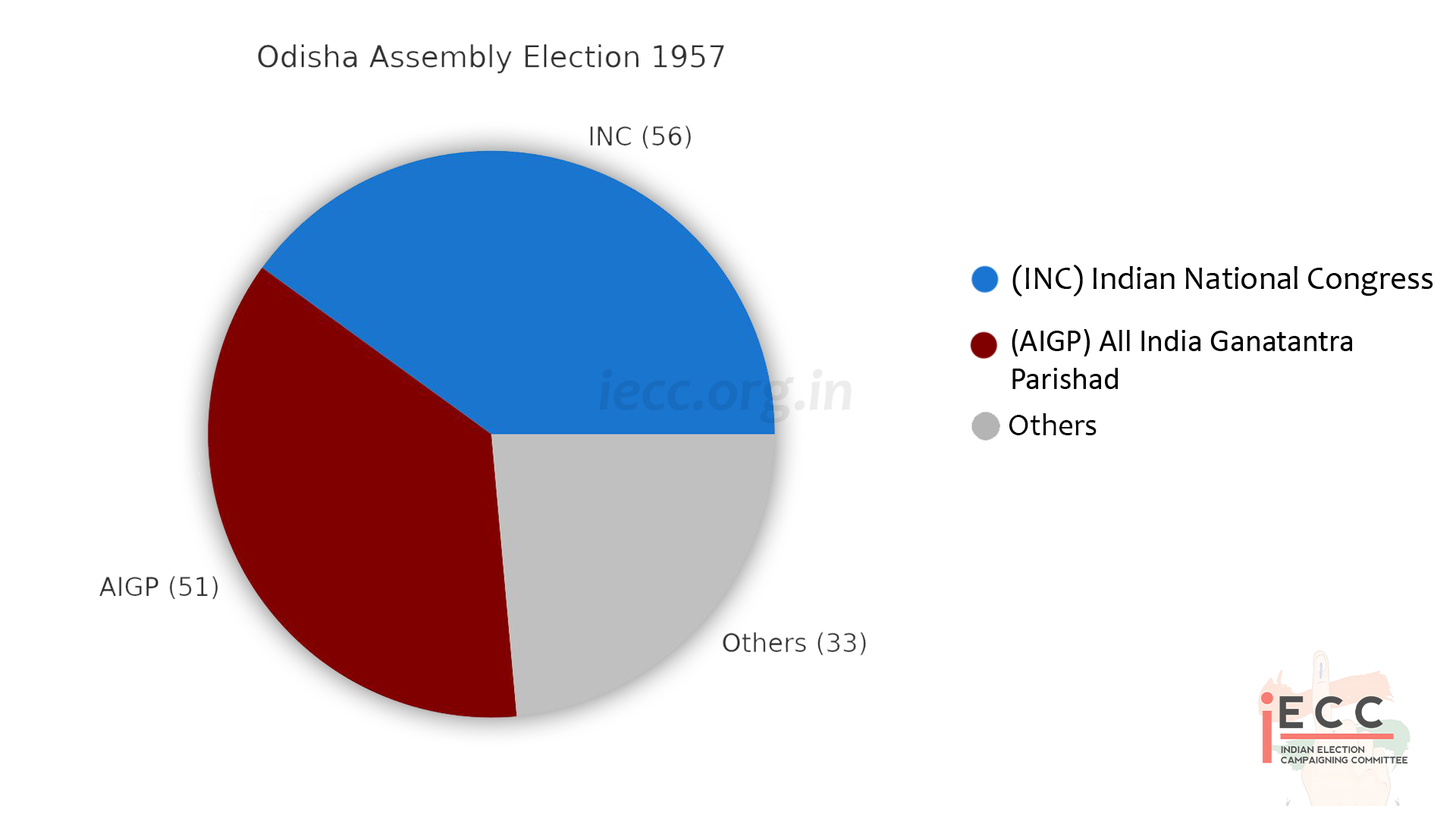
1961 Odisha Assembly Election Results
| 1961 Odisha Assembly Election Results | |||
|---|---|---|---|
| Sr. No. | Short Name | Full Name | Seats |
| 1 | INC | Indian National Congress | 82 |
| 2 | GP | Ganatantra Parishad | 37 |
| 3 | CPI | Communist Party of India | 4 |
| 4 | PSP | Praja Socialist Party | 10 |
| 5 | PSP | Praja Socialist Party | 10 |
| 6 | Independents & Others | Independents & Others | 7 |
| Total | 150 | ||
The 1961 election marked the return of Congress dominance in Odisha after the near-loss of 1957.
Biju Patnaik, a charismatic leader and freedom fighter, became CM and launched several initiatives for industrialization and modernization of Odisha.
His tenure saw major projects like the Hirakud Dam, industrial plants, and efforts to connect Odisha with national economic growth.
The Ganatantra Parishad still held significant regional clout but could not stop Congress’s strong comeback.
This election also reflected the beginning of personality-driven politics in Odisha, with Biju Patnaik becoming a central figure (later his legacy shaped politics through the Biju Janata Dal, founded by his son Naveen Patnaik).
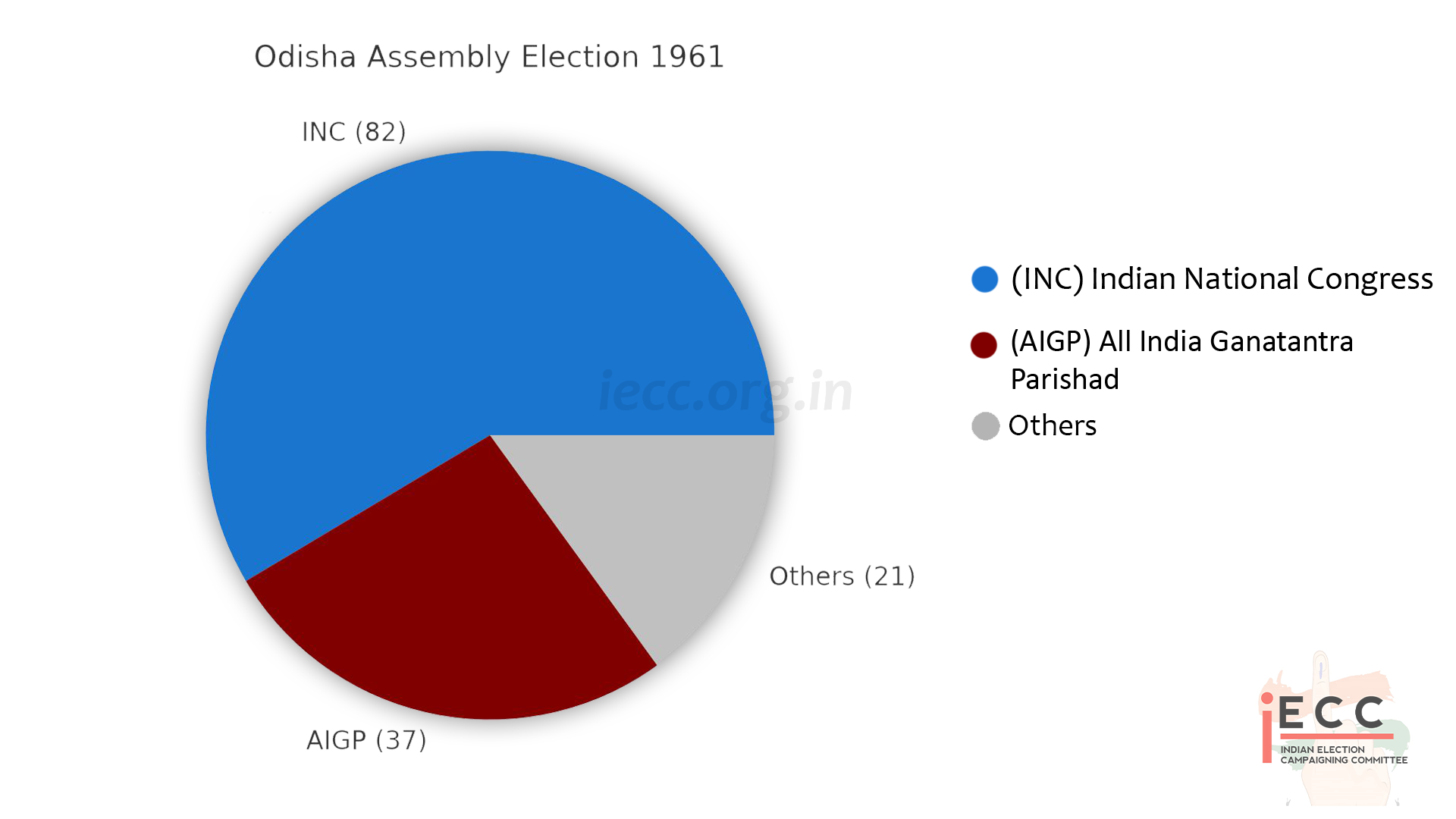
1967 Odisha Legislative Assembly Election Results
| 1967 Odisha Legislative Assembly Election Results | |||
|---|---|---|---|
| Sr. No. | Short Name | Full Name | Seats |
| 1 | INC | Indian National Congress | 31 |
| 2 | Swatantra Party | Swatantra Party | 49 |
| 3 | PSP | Praja Socialist Party | 21 |
| 4 | JC | Jana Congress | 26 |
| 5 | CPI | Communist Party of India | 7 |
| 6 | Others / Independents | Others / Independents | 6 |
| Total | 140 | ||
The 1967 election in Odisha marked the end of Congress’s monopoly in the state’s politics.
The Swatantra Party, founded by C. Rajagopalachari as a right-wing alternative to Congress, gained ground in Odisha under the leadership of Rajendra Narayan Singh Deo.
Since no party got a clear majority, it resulted in a coalition government.
Ultimately, a United Front government was formed with Swatantra Party, PSP, Jana Congress, and others coming together.
Rajendra Narayan Singh Deo (Swatantra Party) became the Chief Minister of Odisha
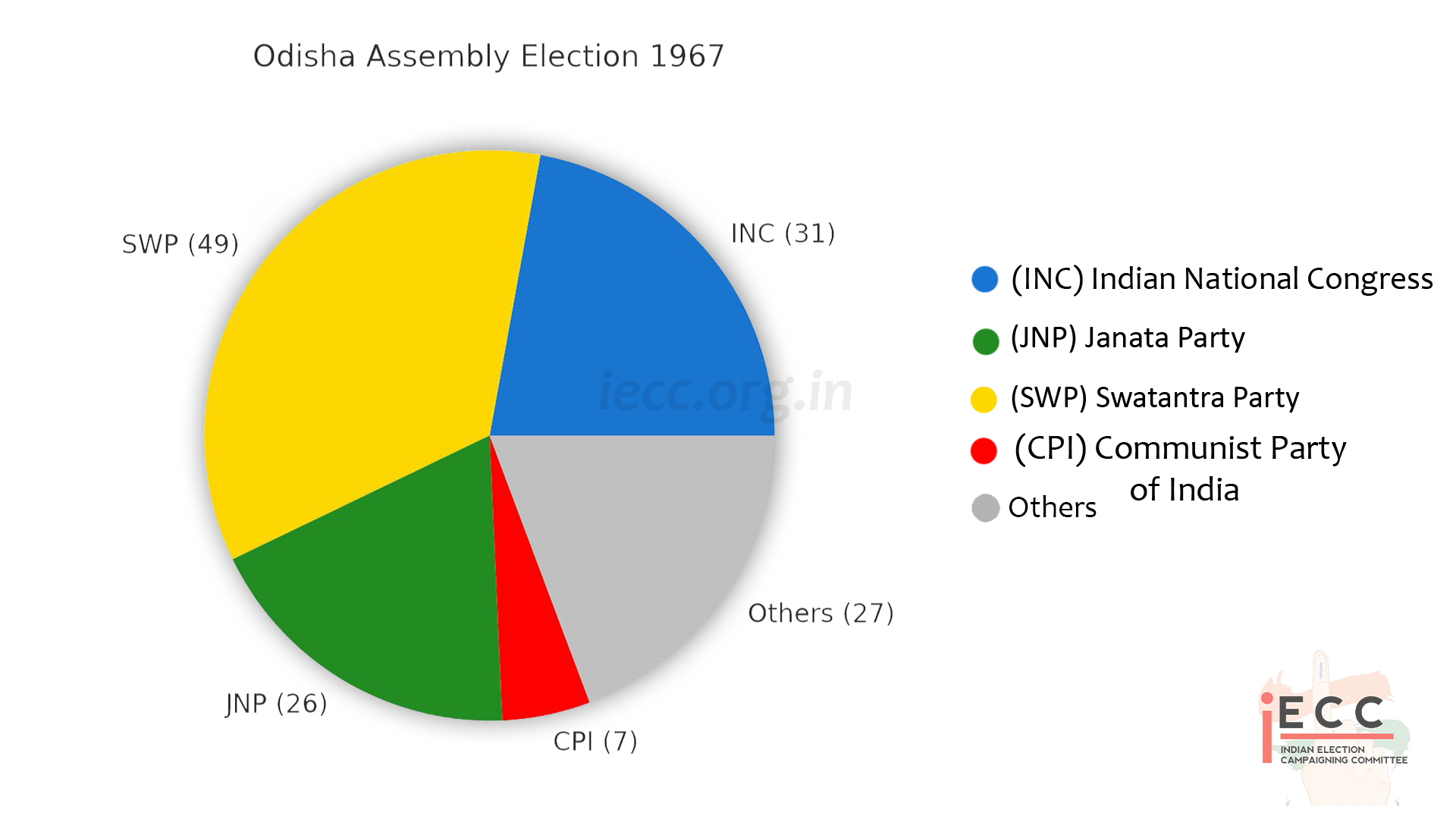
1974 Odisha Legislative Assembly Election Results
| 1974 Odisha Legislative Assembly Election Results | |||
|---|---|---|---|
| Sr. No. | Short Name | Full Name | Seats |
| 1 | INC | Indian National Congress | 69 |
| 2 | UC | Utkal Congress | 35 |
| 3 | Swatantra Party | Swatantra Party | 21 |
| 4 | CPI | Communist Party of India | 7 |
| 5 | Socialist parties / others | Socialist parties / others | 8 |
| 6 | Independents & smaller parties | Independents & smaller parties | 7 |
| 7 | Janata Party | Janata Party | 110 |
| Total | 257 | ||
The 1974 elections again produced a fractured mandate.
Congress (I), under Nandini Satpathy’s leadership, became the single largest party with 69 seats but could not cross the majority mark.
Biju Patnaik’s Utkal Congress (35 seats) and the Swatantra Party (21 seats) together held considerable strength in opposition.
Despite lacking a clear majority, Congress managed to form the government, as some independents and smaller groups extended support.
Nandini Satpathy continued as Chief Minister of Odisha.
This period in Odisha politics was marked by frequent instability and defections, which was common in several Indian states in the 1970s before the rise of stable majority politics
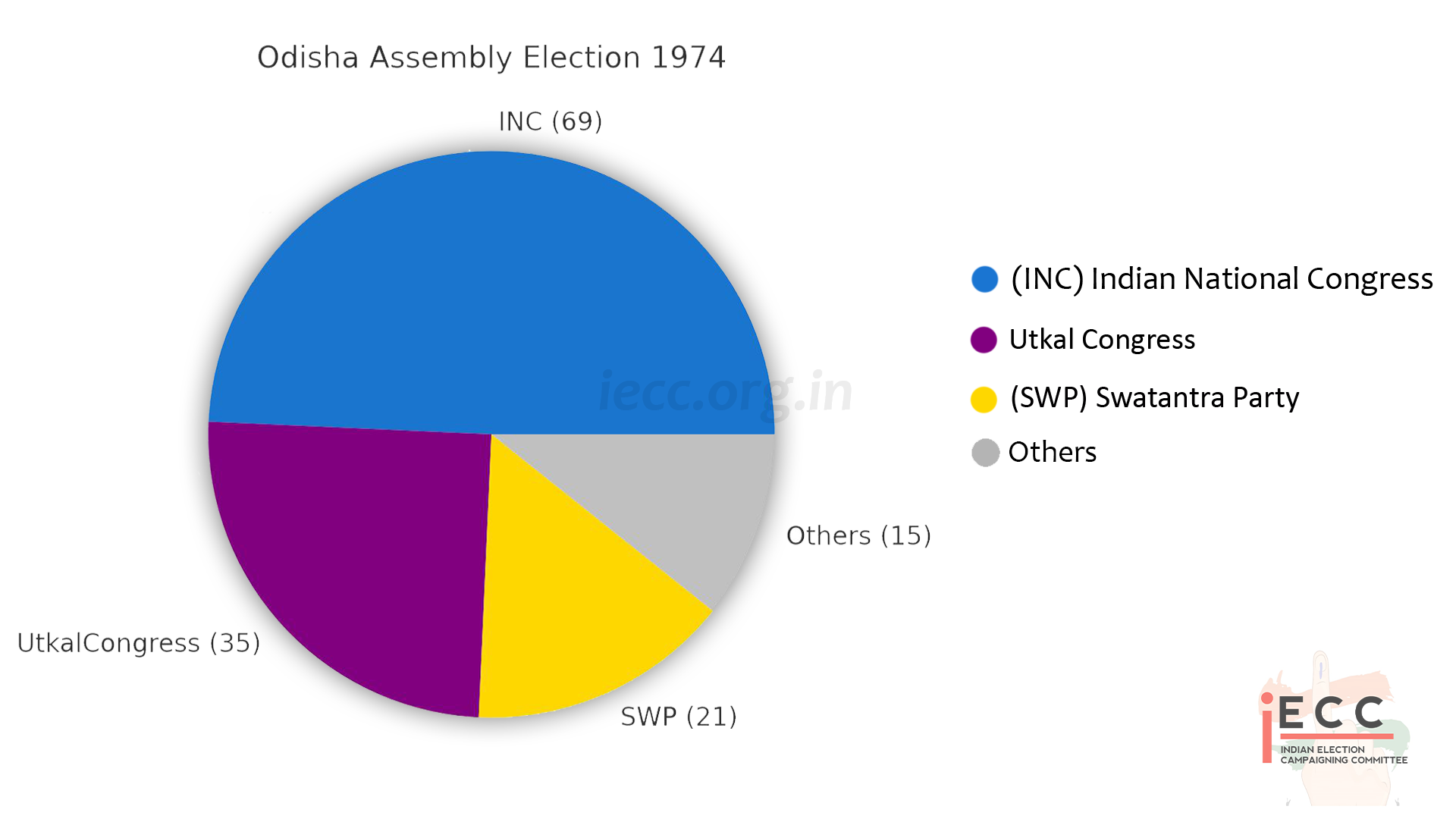
1977 Odisha Legislative Assembly Election Results
| 1977 Odisha Legislative Assembly Election Results | |||
|---|---|---|---|
| Sr. No. | Short Name | Full Name | Seats |
| 1 | Janata Party | Janata Party | 110 |
| 2 | INC | Indian National Congress | 26 |
| 3 | CPI | Communist Party of India | 7 |
| 4 | Others / Independents | Others / Independents | 4 |
| Total | 147 | ||
The Emergency period (1975–77) imposed by Indira Gandhi had caused widespread dissatisfaction across India.
After the Emergency ended, the Janata Party—a coalition of opposition parties (including Swatantra remnants, Bharatiya Lok Dal, Jana Sangh, Socialist groups, and Congress (O))—emerged as a powerful alternative.
In Odisha, the Janata Party achieved a landslide victory, winning 110 out of 147 seats.
The Congress suffered one of its worst defeats in the state, reduced to only 26 seats.
Nilamani Routray (Janata Party) became the Chief Minister of Odisha.
This election was a watershed moment in Odisha politics, as for the first time since independence, Congress was decisively thrown out of power by a united opposition
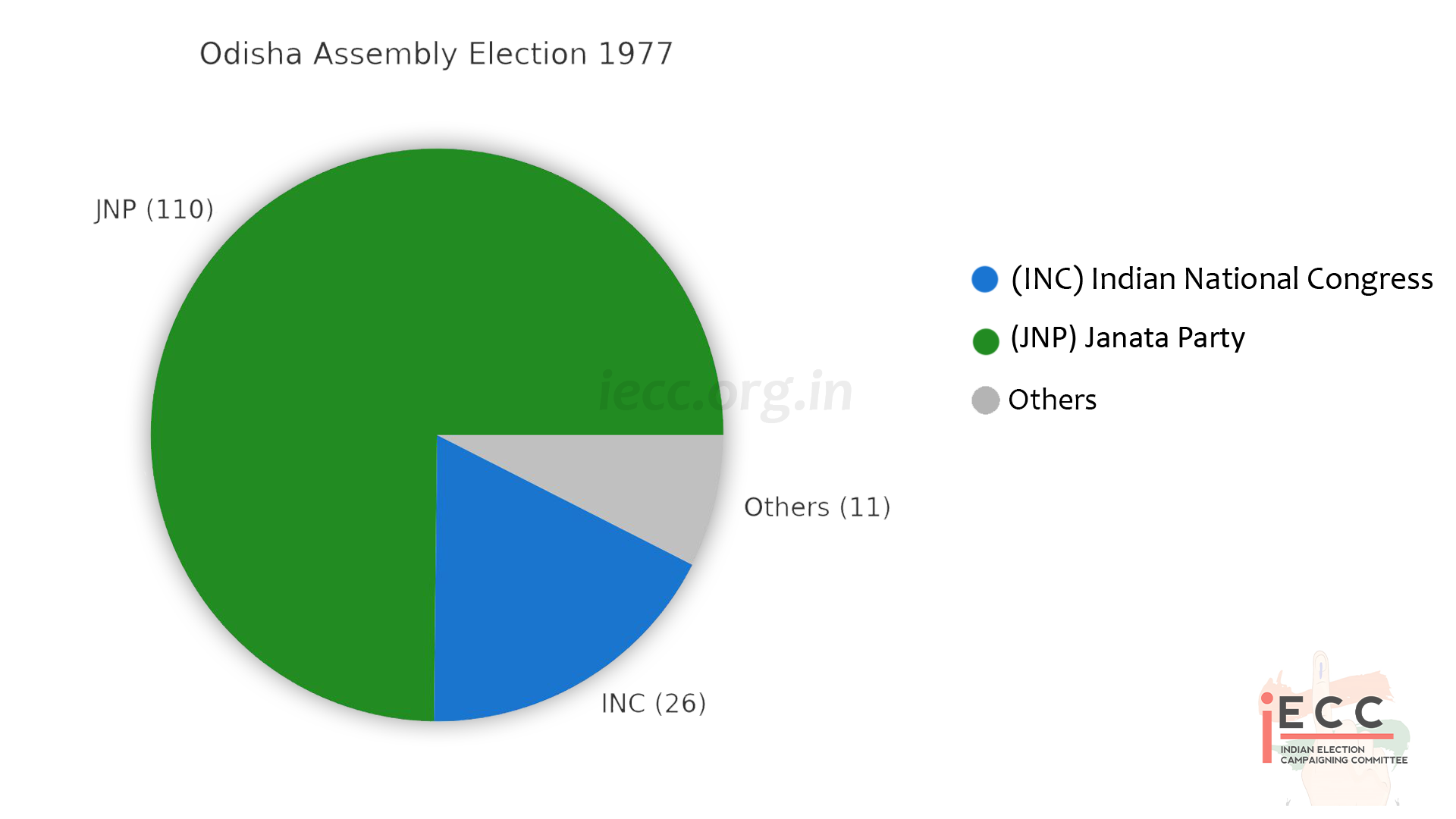
1980 Odisha Legislative Assembly Election Results
| 1980 Odisha Legislative Assembly Election Results | |||
|---|---|---|---|
| Sr. No. | Short Name | Full Name | Seats |
| 1 | INC-l | Indian National Congress | 117 |
| 2 | Janata Party | Janata Party | 21 |
| 3 | CPI | Communist Party of India | 7 |
| 4 | Independents / Others | Independents / Others | 2 |
| Total | 147 | ||
The 1980 elections came soon after the fall of the Janata Party government at the Centre and Indira Gandhi’s dramatic return to power.
Riding on this national pro-Congress wave, the Congress (Indira) swept Odisha with 117 seats, securing a comfortable majority.
The Janata Party, which had dominated in 1977, collapsed to only 21 seats due to internal divisions and the nationwide disillusionment with the Janata experiment.
The CPI retained 7 seats, but their influence remained limited.
J. B. Patnaik (Congress-I) became the Chief Minister of Odisha, marking the beginning of his long political dominance in the state through the 1980s and early 1990s.
This election restored Congress’s supremacy in Odisha, reversing the anti-Congress tide of 1977
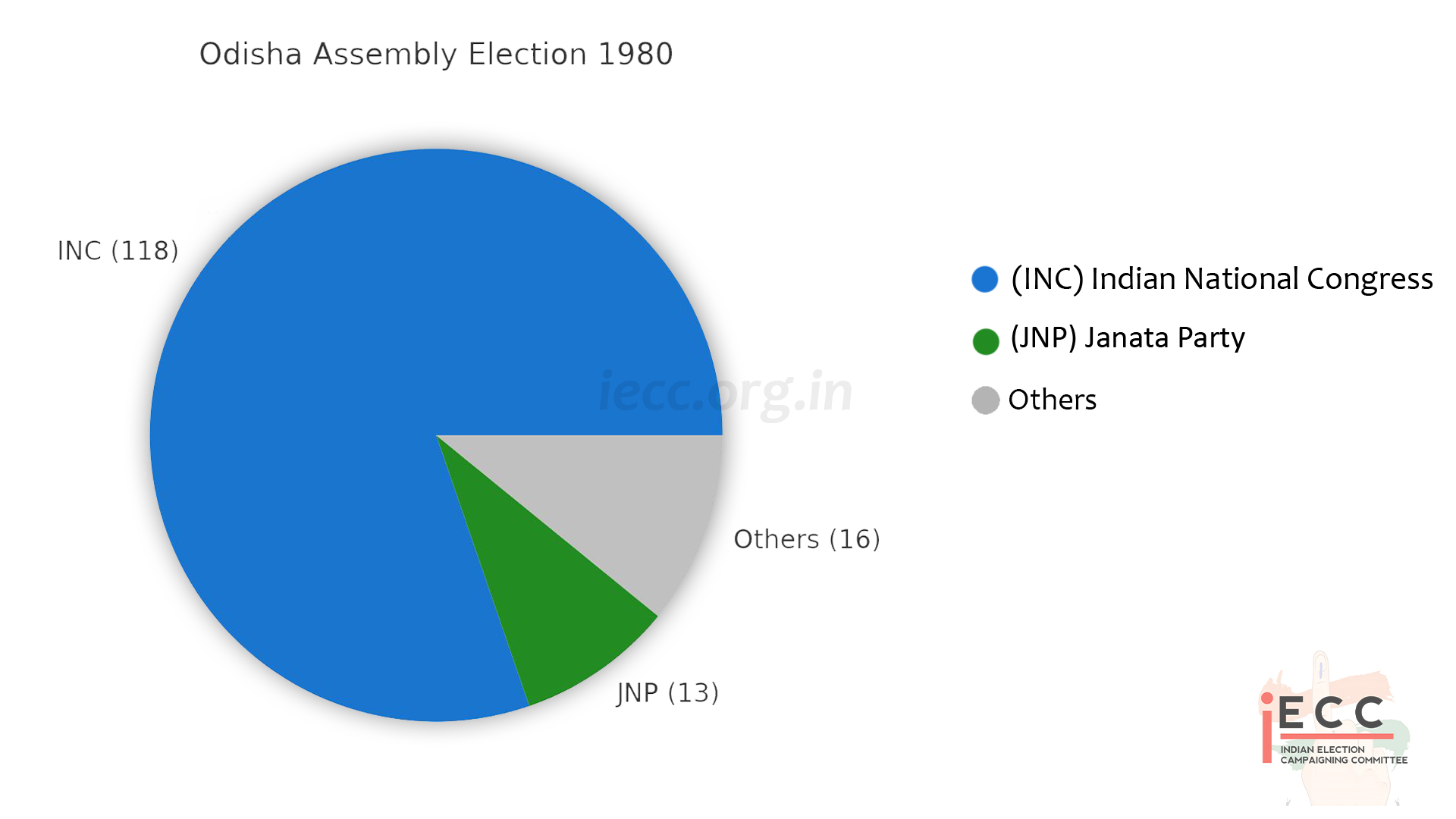
1985 Odisha Legislative Assembly Election Results
| 1985 Odisha Legislative Assembly Election Results | |||
|---|---|---|---|
| Sr. No. | Short Name | Full Name | Seats |
| 1 | INC-l | Indian National Congress | 117 |
| 2 | Janata Party | Janata Party | 21 |
| 3 | CPI | Communist Party of India | 6 |
| 4 | (Marxist) (CPI-M) | Communist Party of India | 1 |
| 5 | Others / Independents | Others / Independents | 2 |
| Total | 147 | ||
The 1985 elections in Odisha reinforced the dominance of the Congress (Indira), which had already swept the state in 1980.
With 117 out of 147 seats, Congress again secured a comfortable majority, repeating its earlier landslide.
The Janata Party, which had collapsed in 1980, failed to recover, remaining at just 21 seats.
The Left parties (CPI, CPI-M) together could win only a handful of seats (7 in total), showing their limited influence in Odisha politics.
J. B. Patnaik (Congress-I) continued as the Chief Minister, further consolidating his control over state politics.
This period marked the peak of Congress dominance in Odisha, with J. B. Patnaik being one of the longest-serving CMs of the state.
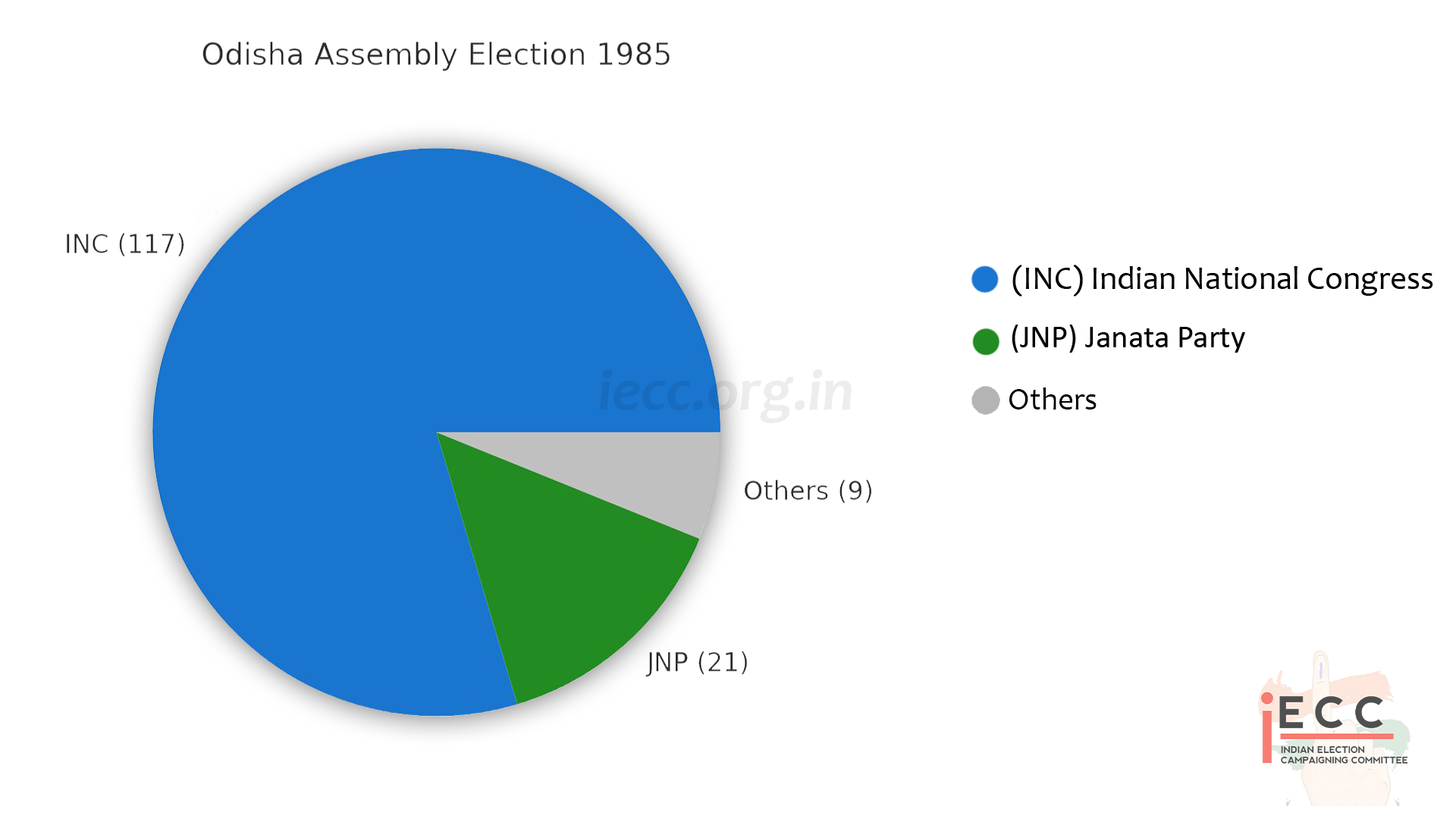
1990 Odisha Legislative Assembly Election Results
| 1990 Odisha Legislative Assembly Election Results | |||
|---|---|---|---|
| Sr. No. | Short Name | Full Name | Seats |
| 1 | Janata Dal | Janata Dal | 123 |
| 2 | INC | Indian National Congress | 10 |
| 3 | CPI | Communist Party of India | 4 |
| 4 | CPI-M | Communist Party of India | 1 |
| 5 | Independents & Others | Independents & Others | 9 |
| Total | 147 | ||
The 1990 election completely changed the political landscape of Odisha.
Riding on the national wave in favour of Janata Dal and led by Biju Patnaik, the party won a stunning 123 seats out of 147—one of the most decisive mandates in Odisha’s history.
The Congress (INC), which had ruled for a decade under J. B. Patnaik, was wiped out, reduced to just 10 seats, its lowest tally ever in the state.
The Left parties (CPI & CPI-M) together managed 5 seats, while independents and smaller groups won 9.
Biju Patnaik was sworn in again as the Chief Minister of Odisha (his second term, after 1961–63).
This election re-established Biju Patnaik as the tallest leader of Odisha, and laid the foundation for the regional politics that later evolved into the Biju Janata Dal (BJD) in 1997 under his son, Naveen Patnaik.
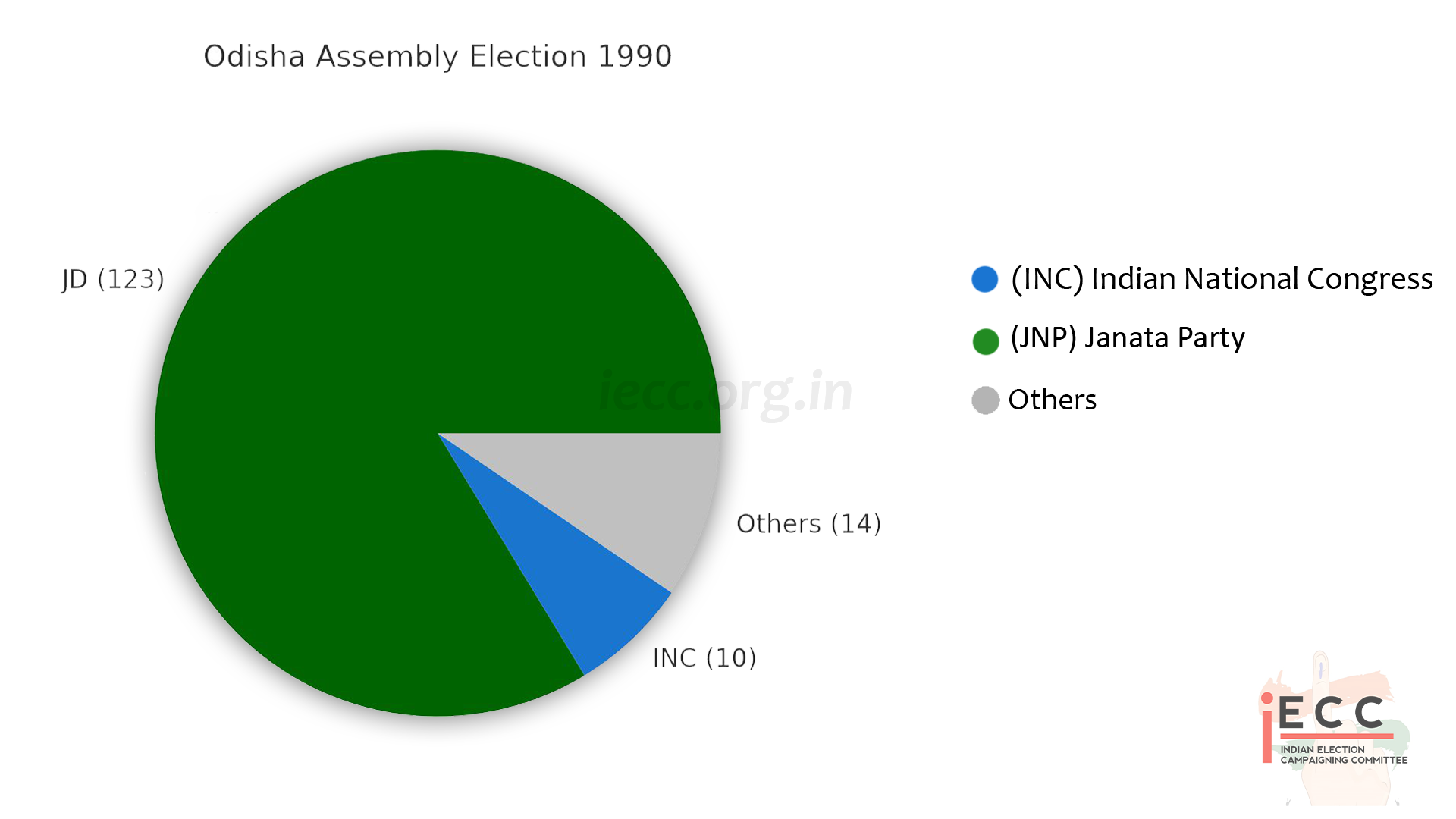
1995 Odisha Legislative Assembly Election Results
| 1995 Odisha Legislative Assembly Election Results | |||
|---|---|---|---|
| Sr. No. | Short Name | Full Name | Seats |
| 1 | INC | Indian National Congress | 80 |
| 2 | Janata Dal | Janata Dal | 46 |
| 3 | BJP | Bharatiya Janata Party | 9 |
| 4 | CPI | Communist Party of India | 1 |
| 5 | Independents & Others | Independents & Others | 11 |
| Total | 147 | ||
The 1995 election marked a major comeback for Congress in Odisha.
After being decimated in 1990, the Congress, led again by J. B. Patnaik, managed to secure a majority with 80 seats.
The Janata Dal, which had swept the 1990 polls under Biju Patnaik, saw a sharp decline to 46 seats. This was partly due to anti-incumbency and internal rifts.
The BJP made its first significant entry in Odisha politics by winning 9 seats, setting the stage for its future alliance with the BJD.
Left parties were almost wiped out, with CPI winning just 1 seat.
J. B. Patnaik returned as the Chief Minister of Odisha, continuing Congress dominance until the late 1990s.
However, this would be the last time Congress won a majority on its own in Odisha, as the rise of regional politics (BJD) and alliances soon reshaped the state’s political scene.
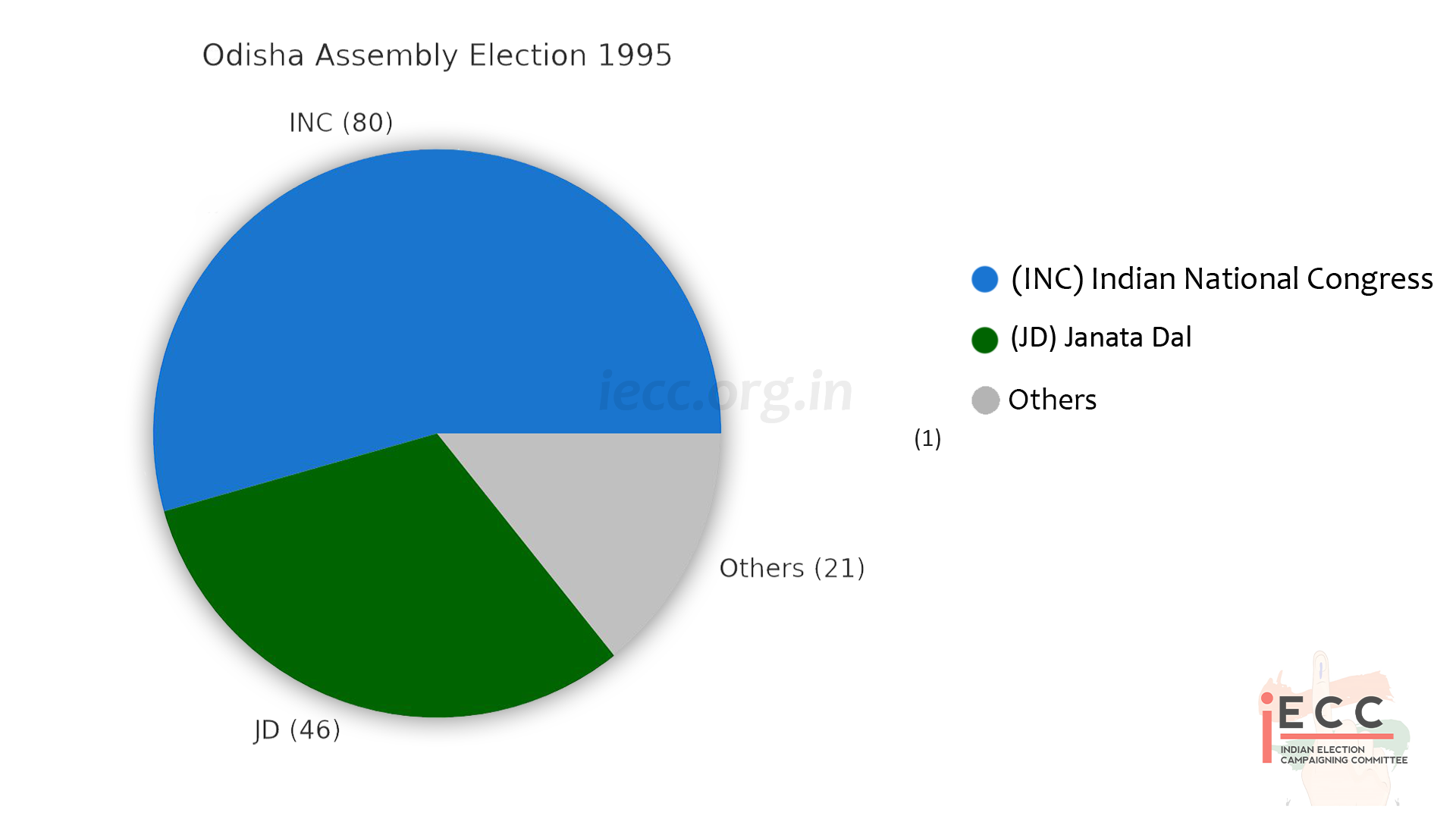
2000 Odisha Legislative Assembly Election Results
| 2000 Odisha Legislative Assembly Election Results | |||
|---|---|---|---|
| Sr. No. | Short Name | Full Name | Seats |
| 1 | BJD+BJP | Biju Janata Dal+Bharatiya Janata Party | 186 |
| 2 | INC | Indian National Congress | 26 |
| 3 | CPI | Communist Party of India | 1 |
| 4 | (Marxist) (CPI-M) | Communist Party of India | 1 |
| 5 | Others / Independents | Others / Independents | 26 |
| Total | 240 | ||
The 2000 elections were a turning point in Odisha politics.
The Biju Janata Dal (BJD), founded in 1997 by Naveen Patnaik (son of Biju Patnaik), contested the election in alliance with the BJP.
Together, they won 93 seats (BJD – 68, BJP – 25), comfortably crossing the majority mark.
The Congress, led by J. B. Patnaik, suffered a major setback, managing only 26 seats.
Left parties were nearly wiped out.
Naveen Patnaik became the Chief Minister of Odisha for the first time in March 2000.
This election marked the end of Congress dominance in Odisha and the beginning of Naveen Patnaik’s long political era, which continues to this day (over two decades in power)
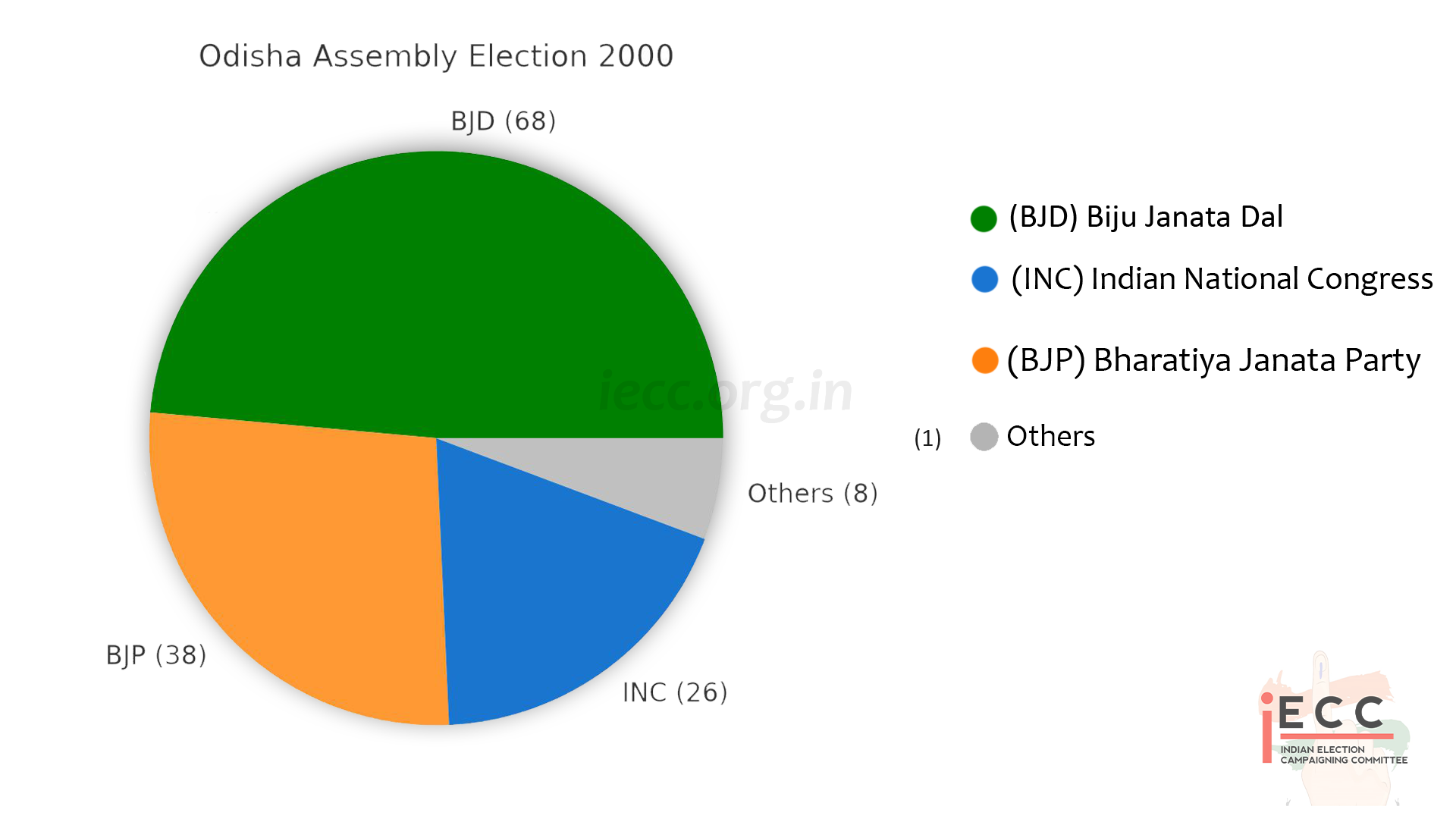
2004 Odisha Legislative Assembly Election Results
| 2004 Odisha Legislative Assembly Election Results | |||
|---|---|---|---|
| Sr. No. | Short Name | Full Name | Seats |
| 1 | BJD | Biju Janata Dal | 61 |
| 2 | BJP | Bharatiya Janata Party | 32 |
| 3 | BJD–BJP Alliance Total | BJD–BJP Alliance Total | 93 |
| 4 | INC | Indian National Congress | 38 |
| 5 | CPI | Communist Party of India | 1 |
| 6 | JMM | Jharkhand Mukti Morcha | 4 |
| 7 | Others / Independents | Others / Independents | 10 |
| Total | 239 | ||
The 2004 elections in Odisha were held simultaneously with the Lok Sabha elections.
The BJD-BJP alliance once again secured a majority with 93 seats (BJD 61 + BJP 32), ensuring the continuation of their coalition government.
The Congress improved slightly from 2000 but still remained far from power, winning 38 seats.
Smaller parties like JMM and independents held only marginal influence.
Naveen Patnaik was sworn in again as the Chief Minister of Odisha, beginning his second term.
This election reinforced Naveen Patnaik’s image as a clean and efficient leader, while the Congress struggled with internal divisions and leadership issues
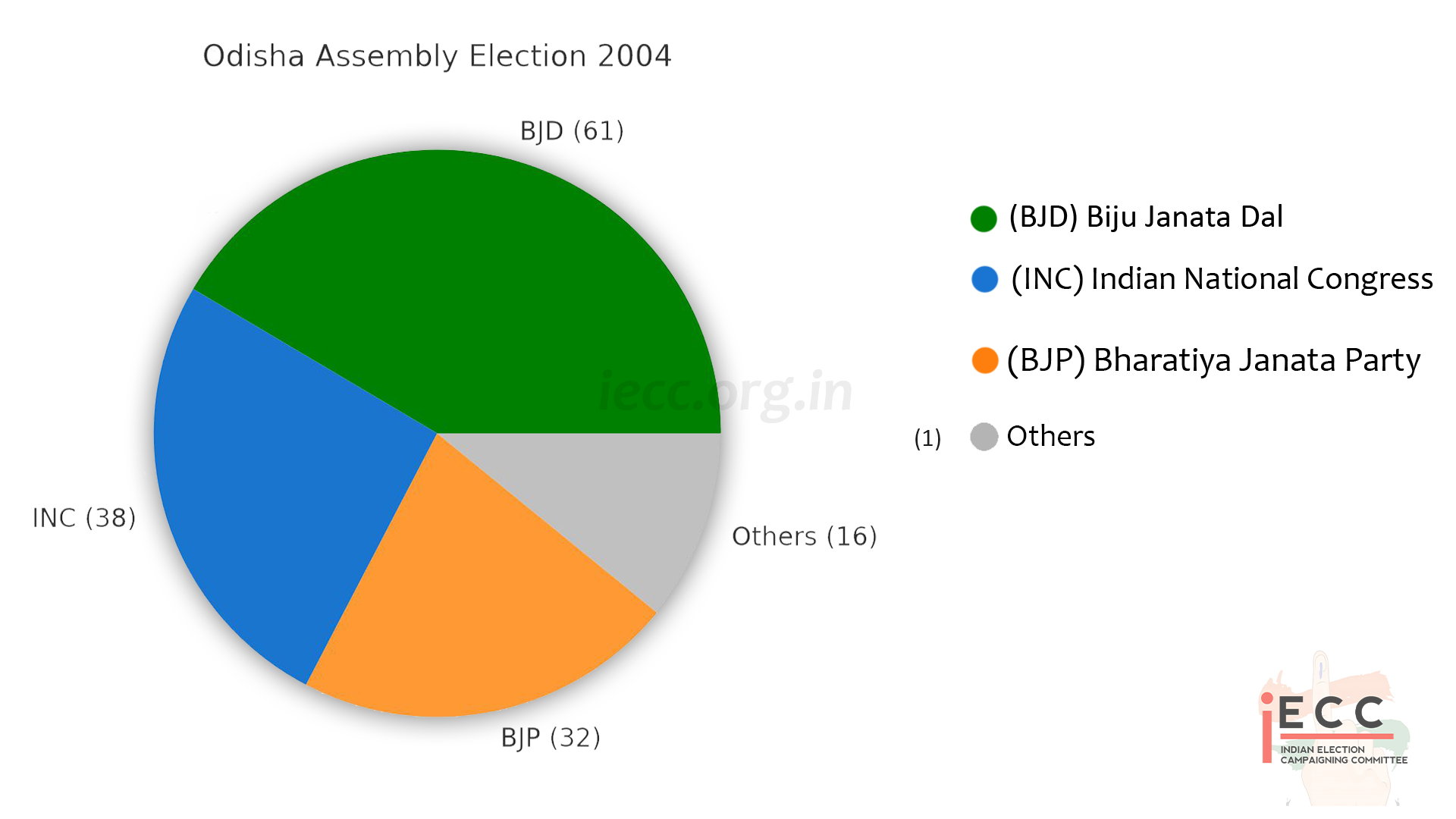
2009 Odisha Legislative Assembly Election Results
| 2009 Odisha Legislative Assembly Election Results | |||
|---|---|---|---|
| Sr. No. | Short Name | Full Name | Seats |
| 1 | BJD | Biju Janata Dal | 103 |
| 2 | INC | Indian National Congress | 27 |
| 3 | BJP | Bhartiya Janata Party | 6 |
| 4 | CPI | Communist Party of India | 1 |
| 5 | (Marxist) (CPI-M) | Communist Party of India | 1 |
| 6 | NCP | Nationalist Congress Party | 4 |
| 7 | JMM | Jharkhand Mukti Morcha | 1 |
| 8 | Independents & Others | Independents & Others | 4 |
| Total | 147 | ||
The 2009 elections were a turning point in Odisha politics because Naveen Patnaik’s BJD ended its alliance with BJP (after the Kandhamal riots controversy) and contested independently for the first time since its formation.
The decision proved successful: the BJD scored a landslide victory with 103 seats, crossing the majority mark on its own.
The Congress failed to revive, winning only 27 seats.
The BJP suffered a complete collapse, reduced to just 6 seats, a dramatic fall from its earlier strong position in the state.
Other smaller parties (NCP, CPI, CPI-M, JMM) and independents had only a symbolic presence.
Naveen Patnaik was sworn in for his third consecutive term as Chief Minister, establishing himself as the unchallenged leader of Odisha.
This election marked the rise of BJD as the single dominant party in the state, beginning an era of one-party dominance that continues today
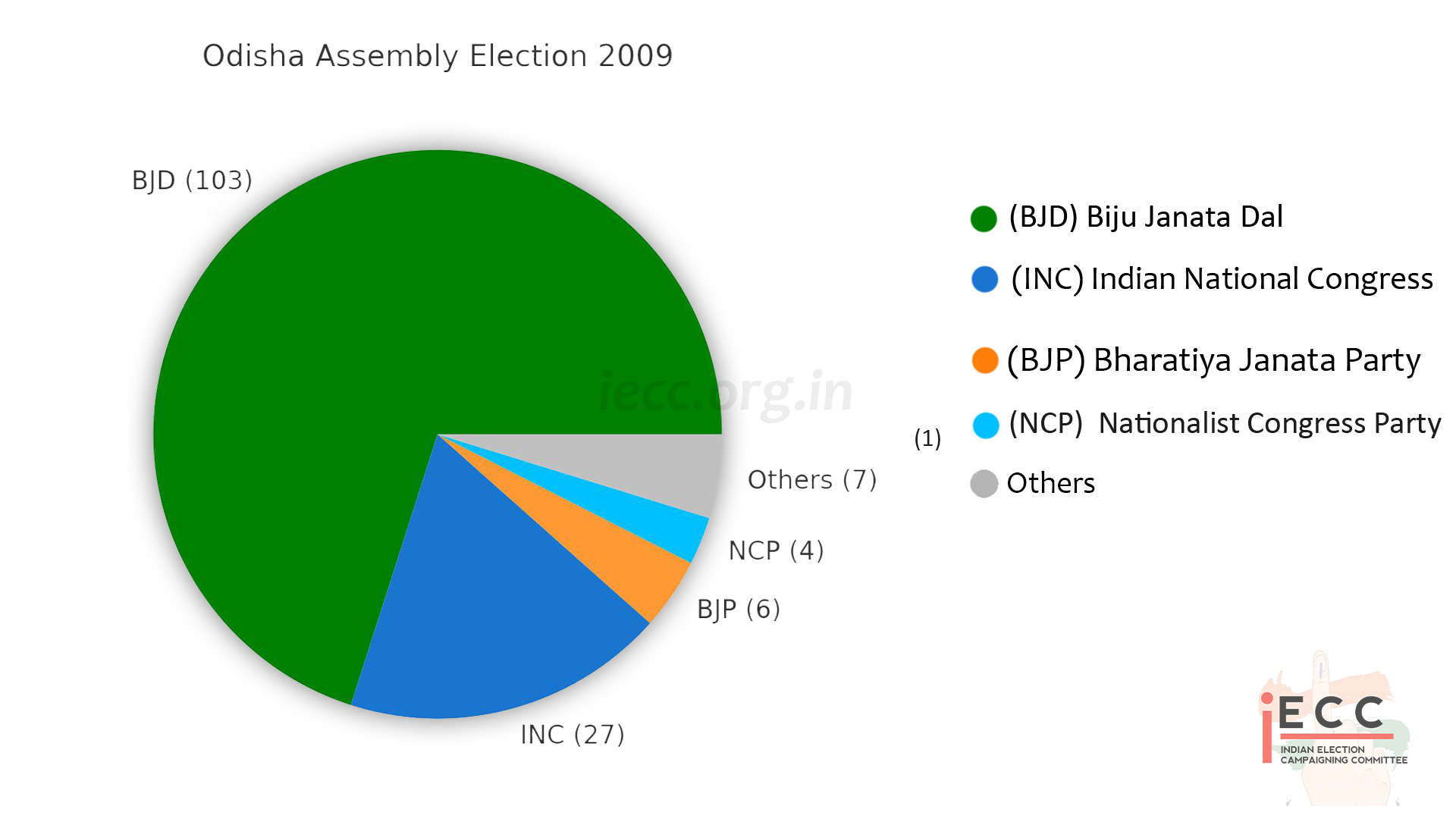
2014 Odisha Legislative Assembly Election Results
| 2014 Odisha Legislative Assembly Election Results | |||
|---|---|---|---|
| Sr. No. | Short Name | Full Name | Seats |
| 1 | BJD | Biju Janata Dal | 117 |
| 2 | INC | Indian National Congress | 16 |
| 3 | BJP | Bharatiya Janata Party | 10 |
| 4 | CPI | Communist Party of India | 1 |
| 5 | SKD | Samata Kranti Dal | 1 |
| 6 | Independents & Others | Independents & Others | 2 |
| Total | 147 | ||
The 2014 election was held simultaneously with the Lok Sabha polls.
Riding on Naveen Patnaik’s popularity, governance record, and welfare schemes (like subsidized rice, women’s empowerment programs, and disaster management efforts), the BJD scored a thumping victory with 117 seats.
This was the party’s best-ever performance, securing almost 80% of the assembly seats.
The Congress collapsed to just 16 seats, its worst performance in state history, and virtually ceased to be a serious challenger.
The BJP showed some signs of revival, winning 10 seats, aided by the Narendra Modi wave at the national level.
Left parties and smaller outfits were almost irrelevant.
Naveen Patnaik became Chief Minister for the fourth consecutive term, further cementing his dominance over Odisha politics.
By this stage, Odisha had effectively become a BJD stronghold, with Naveen Patnaik’s image overshadowing all opposition.
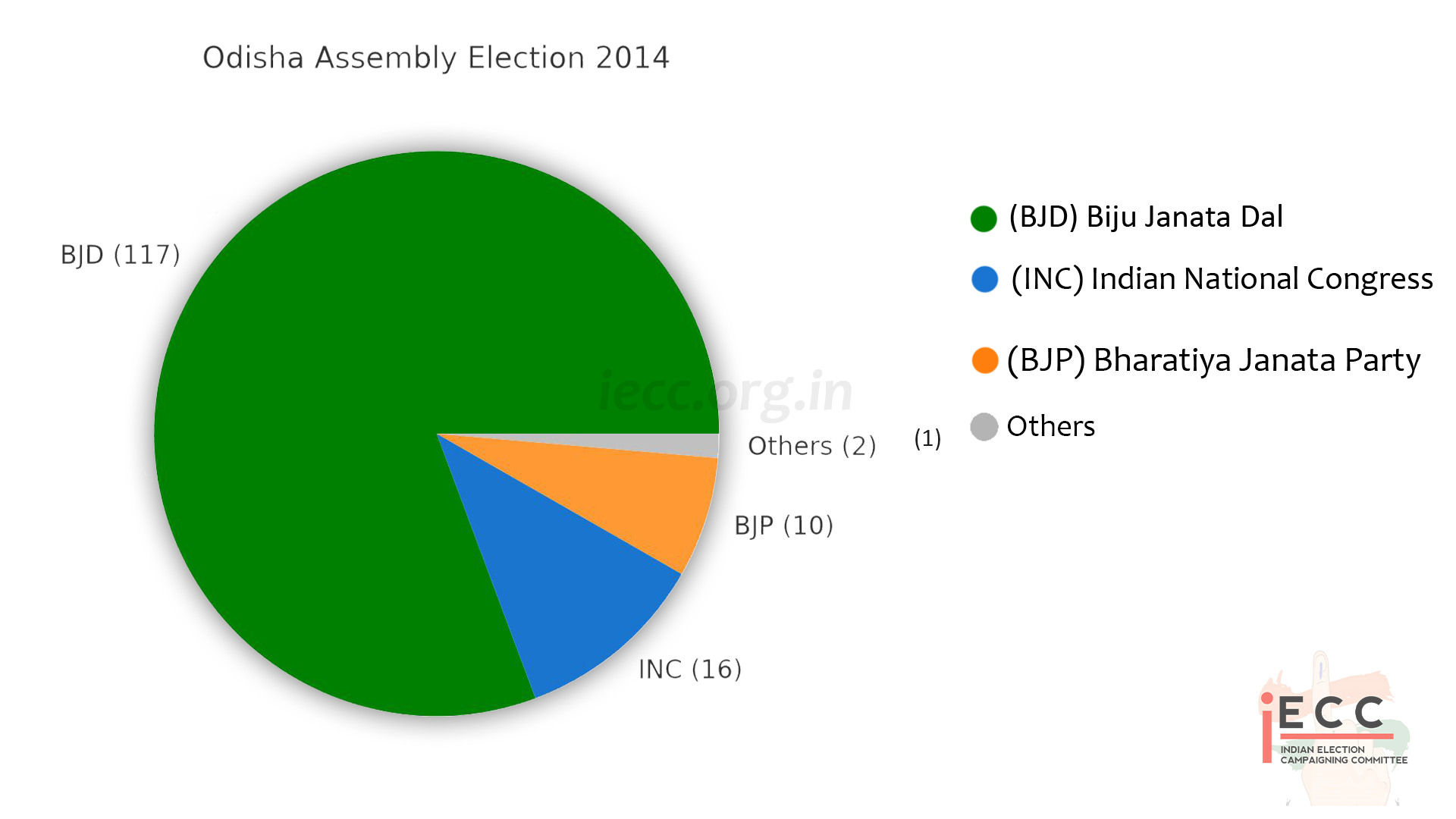
2019 Odisha Legislative Assembly Election Results
| 2019 Odisha Legislative Assembly Election Results | |||
|---|---|---|---|
| Sr. No. | Short Name | Full Name | Seats |
| 1 | BJD | Biju Janata Dal | 112 |
| 2 | BJP | Bharatiya Janata Party | 23 |
| 3 | INC | Indian National Congress | 9 |
| 4 | CPI | Communist Party of India | 0 |
| 5 | (Marxist) (CPI-M) | Communist Party of India | 0 |
| 6 | Others / Independents | Others / Independents | 3 |
| Total | 147 | ||
The 2019 election in Odisha was held simultaneously with the Lok Sabha elections.
Despite the nationwide Modi wave in favor of the BJP, the Biju Janata Dal (BJD) under Naveen Patnaik retained its dominance, winning 112 seats and securing a comfortable majority.
This victory gave Naveen Patnaik a historic 5th consecutive term as Chief Minister, making him one of India’s longest-serving CMs.
The BJP made significant inroads, rising from 10 seats in 2014 to 23 seats, and replaced the Congress as the main opposition party in Odisha.
The Congress collapsed further, reduced to just 9 seats, its weakest tally in Odisha’s electoral history.
Left parties lost all representation, showing their complete decline in the state.
The result reaffirmed Odisha as a BJD bastion, while also highlighting the BJP’s rise as the only real challenger to Naveen Patnaik’s leadership in the future
